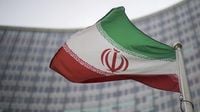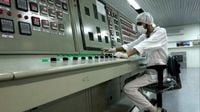Iran’s nuclear ambitions have once again come under international scrutiny after a confidential report by the United Nations’ nuclear watchdog revealed that the country significantly increased its stockpile of uranium enriched to near weapons-grade levels just before Israel launched its military attack on June 13, 2025. The report, compiled by the Vienna-based International Atomic Energy Agency (IAEA) and circulated to member states, was obtained by multiple news outlets including The Associated Press and BBC, and its findings have sent ripples through diplomatic circles worldwide.
According to the IAEA report, as of June 13, 2025, Iran had amassed 440.9 kilograms (972 pounds) of uranium enriched up to 60%. This marks an increase of 32.3 kilograms (71.2 pounds) since the agency’s previous assessment in May. This material, experts caution, is just a short technical step away from weapons-grade enrichment—90% purity—raising alarms over the potential for rapid weaponization. The IAEA clarified that, “approximately 42 kilograms of 60% enriched uranium is theoretically enough to produce one atomic bomb, if enriched further to 90%.”
The report’s figures are based on information provided by Iran, IAEA verification activities conducted between May 17 and June 12, and estimates derived from the past operation of relevant facilities. Since the start of the Israeli military campaign on June 13, however, the IAEA has not been able to conduct the in-field activities required to collect and verify Iran’s declarations about its uranium stockpile. This gap in oversight is now more than two and a half months long—a situation the IAEA has described as “a matter of serious concern.”
Iran’s total enriched uranium stockpile, not just the highly enriched portion, also saw a significant jump. As of June 13, the total was 9,874.9 kilograms (21,770.4 pounds), representing a 627.3-kilogram (1,382.9-pound) increase since May. These numbers, while technical, have very real implications for global security and nonproliferation efforts.
The lack of access for international inspectors is not merely a technicality; it’s a major stumbling block for the IAEA’s ability to provide credible assurances about the peaceful nature of Iran’s nuclear activities. The only site that inspectors have been able to access since the outbreak of hostilities has been the Bushehr Nuclear Power Plant, which operates with Russian technical assistance. IAEA inspectors observed a fuel replacement at Bushehr on August 27 and 28, but all other sites—especially those affected by Israeli and U.S. bombings—remain off limits.
The withdrawal of UN inspectors during the conflict was, according to the IAEA report, “necessary given the overall security situation.” However, Tehran’s subsequent decision to cut cooperation with the agency was described by IAEA Director General Rafael Grossi as “deeply regrettable.” Grossi emphasized in the report that “technical modalities to enable the full resumption of Agency inspection should be concluded without delay.”
Iran’s refusal to allow inspectors back in is not just a bureaucratic standoff. On July 2, Iranian President Masoud Pezeshkian signed a law adopted by the Iranian Parliament to suspend all cooperation with the IAEA. This move came in the wake of both Israeli and U.S. airstrikes targeting Iranian nuclear and military sites—the U.S. notably dropping bunker-buster bombs on nuclear facilities on June 22. The Iranian government has long insisted that its nuclear program is peaceful, but it remains the only non-nuclear-armed nation enriching uranium to such high levels. Both the U.S. and the IAEA, along with other international observers, assess that Iran maintained a nuclear weapons program up until 2003.
The diplomatic fallout from these developments has been swift. France, Germany, and the United Kingdom triggered the process of reimposing sanctions on Iran on August 28, 2025. This so-called “snapback” mechanism, built into the 2015 nuclear deal, is designed to be veto-proof at the United Nations and will take effect in 30 days unless a new diplomatic agreement is reached. European officials have indicated they might be willing to extend the deadline if Iran resumes direct negotiations with the U.S., allows IAEA inspectors access to its nuclear sites, and provides a full accounting for its highly enriched uranium stockpile. As of now, Iran has not met any of these conditions.
The IAEA report also details ongoing, if halting, negotiations between Iran and the agency. In August, a technical team from the IAEA traveled to Tehran for discussions, and on August 14, Iran sent a letter proposing a “new arrangement.” Under this proposal, the IAEA would need to submit requests for inspections of undamaged facilities on a case-by-case basis. For sites damaged in the bombings, Iran offered to provide the agency with a report within a month of finalizing the arrangement, after which further negotiations on inspection protocols would take place. Grossi, the IAEA chief, made it clear to Iranian officials that any future cooperation must comply with the nuclear safeguards agreement Tehran has with the agency.
Meanwhile, the IAEA’s inability to verify Iran’s near bomb-grade uranium stockpile has left the international community in a precarious position. Without independent verification, it’s impossible to determine whether Iran has diverted material for non-peaceful uses, or whether the stockpile has changed in ways that could further destabilize the region. The IAEA is legally mandated to monitor Iran’s nuclear program under the Treaty on the Non-Proliferation of Nuclear Weapons, and the current impasse threatens the very foundation of that international agreement.
It’s important to note that Iran’s insistence on the peaceful nature of its nuclear program is not new. For years, Iranian officials have maintained that their enrichment activities are solely for civilian energy and medical purposes. Yet, as the only non-nuclear-armed state enriching uranium to such high levels, Iran’s actions continue to raise suspicions among Western powers and regional rivals alike.
As the clock ticks down on the snapback sanctions deadline, the world watches closely. The next round of talks between Iran and the IAEA is scheduled to take place in Vienna “in the next few days,” according to the report. Whether these discussions will yield a breakthrough remains uncertain. What is clear, however, is that the stakes have rarely been higher for nuclear diplomacy in the Middle East.
The recent revelations underscore the fragility of international monitoring mechanisms and the challenges of enforcing nonproliferation in a region fraught with conflict and mistrust. As diplomatic efforts intensify, all eyes remain on Tehran—and on the inspectors who, for now, are still waiting for the green light to return.


